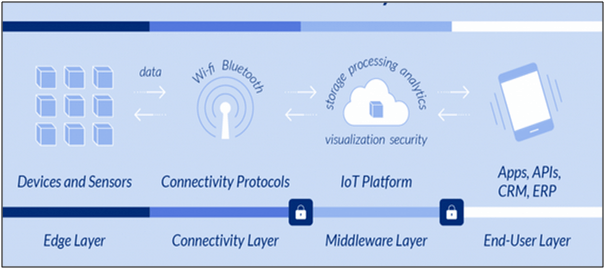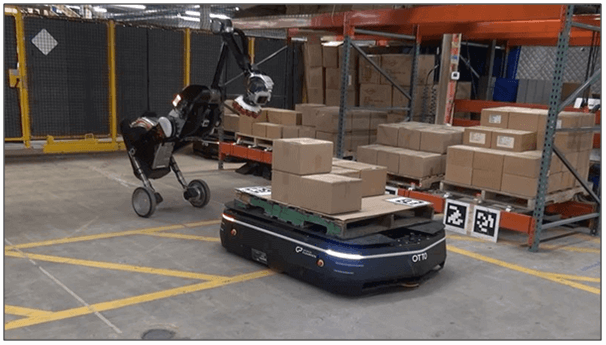The Digitization of the Supply Chain enables companies to address the new requirements of the customer as well as the challenges faced on the Supply side. The concept of a Digital Supply Chain relies heavily on the utilization of real time data that is transmitted from a variety of sources. These technologies are essential in the functioning of the Digital Supply Chain and include the Internet of Things (IoT) and Artificial Intelligence.
Table of Contents
Internet of Things (IoT)
Internet of Things (IoT) is defined as a system of physical things embedded with sensors, software, electronics, and connectivity. An end-to –end IoT system typically includes the collection of information through hardware devices such as sensors . These information can then be transmitted to a common data center such as Cloud. The data uploaded is then analyzed and can be accessed by users through an online app or dashboard.

There has been an influx of smart and connected devices in the last 5 years. Based on Gartner’s past prediction, there will be 37 billion connected devises in 2020 which reflects the importance and significance of IoT on a Digital Supply Chain.
IoT for Digital Supply Chains
IoT is an essential technology in a digital supply chain as it is able to increase forecast accuracy, improve inventory control and allows a smarter transport system to be put in place.Forecast accuracy can be increased by adopting IoT in a company’s supply chain. IoT allows data to be collected automatically through different devices at all times. This reduces human error which enables supply chain managers to come up with demand forecasts that are more accurate through improved data accuracy.
Inventory control is an important function of warehouse and supply chain management for which companies can benefit from the utilization of IoT. Advanced IoT sensors such as RFID and Bluetooth trackers can be used to track and analyze inventory positions and stocks levels, allowing warehouse professionals to have an accurate inventory tracking system which reflects real-time changes.

IoT ensures visibility in the Supply Chain as companies are able to track the status of incoming shipment as well as outgoing cargo. Logistics providers can now utilize geo-fencing technology, where a truck’s onboard computer sends an email alert to a store when a driver is within a certain range. These alerts allow the store personnel to get organized and be ready for the delivery, adding efficiencies all around.
Artificial Intelligence
Artificial Intelligence is a generic term involving various computer algorithms and approaches that enable machines to act and react like humans do and even perform beyond what humans are capable of.
Machine Learning is a subset of AI and refers to taking data and “learning” from them. Machine Learning Systems are able to make predictions or decisions from these data and is able to perform tasks such as facial recognition, speech recognition and even translation.Deep learning is a subset of Machine Learning. It uses many different layers of neural networks to come up with algorithms so as to find the best way to perform specific tasks. The neural network allows the program to break a problem down into simpler parts so that analysis can be carried out.
Like IoT, AI is deemed to be an essential technology in digital supply chains as it improves demand forecast and inventory management, enhances warehouse and logistics operations and makes procurement activities more efficient.
Demand Forecast and Inventory Management
Based on Gartner’s survey, Machine Learning, a sub-set of AI, is an application that is widely used when it comes to demand forecasting. The result shows that 45% of the companies are already utilizing AI when it comes to demand forecasting while 43% of these companies are looking into adopting the technology within the next two years.
Improving demand forecast is essential for the supply chain operations of any companies. Having excessive inventory increases cost but not having sufficient inventory will result in losing out on potential sales. By using machine learning algorithms that “learns” from existing and historical data, better predictions are made over time.
An example of a AI powered initiative is the Multi-Echleon Inventory Optimization (MEIO) module. The MEIO module seeks to set inventory levels according to forecasted demand through the provision of optimal inventory parameters and stocking location so that the right balance of inventory is replenished at the right time.

According to McKinsey Digital, AI-powered forecasting modules like MEIO can reduce errors by 30 to 50% in supply chain networks. This increased accuracy has proved AI as an essential technology in a digital supply chain as it helps to increase customer satisfaction which improves brand perception and reinforce customer loyalty over time.
Warehousing and Logistics Operations
Apart from improving demand forecasting and inventory management, AI can also enhance Warehouse and Logistics Operations through the use of autonomous vehicles, autonomous mobile robots (AMR) and route optimization technology.
UPS is utilizing their route optimization technology, ORION (On-Road Optimization and Navigation) for their last mile delivery service. The result has proved to be encouraging as they managed to save 3 million gallon of fuel during the testing phase in 2010-2012. It has been projected that the technology will result in cost savings of up to S$50 million by reducing 1 mile from each driver’s route on a day-to-day basis.
Autonomous vehicles is another area which many companies are looking into For instance, KFC in China has worked with Yeolix and Yum on driverless vehicles for food delivery. This is especially essential amidst Covid-19 where the reduction in physical contact would help to kerb the spread of the virus.

Autonomous Mobile Robots (AMRs) can also help in enhancing warehouse operations. An example of this would be Fetch Robotics which has developed collaborative AMRs for locating, tracking and moving inventory in warehouse facilities. AMRs can free human workforce from more mundane tasks and allow them to focus on other strategic and value-added activities. The widespread adoption of AMRs is expected in the coming years due to the above benefits.

AI for Procurement
AI can help optimize and enhance procurement activities through various analytics software. The use of spend analytics software can minimize the time needed for procurement professionals to go through data manually. Data is sent through a centralized system before they are classified and tabulated. Mistakes are spotted and highlighted to the users and records are maintained digitally.
The full content is only visible to SIPMM members
Already a member? Please Login to continue reading.
References
Alok Sharma, ADPSM. (2019). “Using AI Analytics to Avoid Supply Chain Disruption”. Retrieved from SIPMM: https://publication.sipmm.edu.sg/using-ai-analytics-avoid-supply-chain-disruption/, accessed 21/03/2021.
Andrew Williams (2018). “How Autonomous Mobile Robots Are Changing the Logistics Landscape”. Retrieved from https://www.roboticsbusinessreview.com/supply-chain/autonomous-mobile-robots-changing-logistics-landscape/, accessed 22/03/2021.
Cem Dilmegani. (2021). “Demand forecasting in the age of AI & machine learning [2021]”. Retrieved from https://research.aimultiple.com/demand-forecasting/, accessed 22/03/2021.
Future Supply Chain (2021). “McDonald’s Is Using AI and Data to Optimize Its Supply Chain”. Retrieved from https://supplychainnext.wbresearch.com/blog/mcdonalds-ai-data-optimize-supply-chain, accessed 23/03/2021.
Jason Ng, GDSCM. (2018). “Artificial Intelligence on Digital Supply Chain”. Retrieved from SIPMM: https://publication.sipmm.edu.sg/application-impact-artificial-intelligence-digital-supply-chain/, accessed 22/03/2021.
Mortson Enterprises Inc. (2021). “The Internet of Things (IoT)- Welcome the Digital Supply Chain!”. Retrieved from https://supplychaingamechanger.com/internet-things-iot-welcome-digital-supply-chain/, accessed 22/03/2021.
Sean Szymkowski. (2020). “KFC rolls out self-driving food trucks in China and it’s sort of wild”. Retrieved from https://www.cnet.com/google-amp/news/kfc-food-trucks-self-driving-china/, accessed 22/03/2021.
Wong Kok Fu, ADPSM. (2019). “Internet-of Thing (IoT) Applications for Digital Procurement”. Retrieved from SIPMM: https://publication.sipmm.edu.sg/internet-of-thing-iot-applications-digital-procurement, accessed 21/03/2021.


